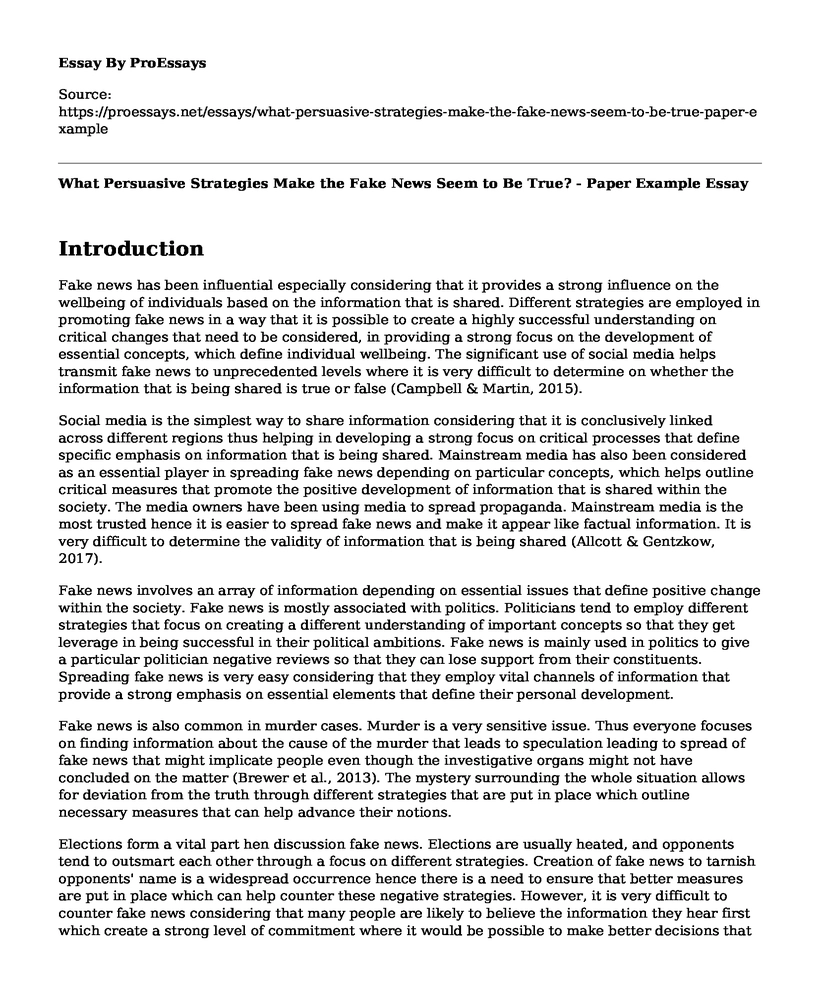Introduction
Fake news has been influential especially considering that it provides a strong influence on the wellbeing of individuals based on the information that is shared. Different strategies are employed in promoting fake news in a way that it is possible to create a highly successful understanding on critical changes that need to be considered, in providing a strong focus on the development of essential concepts, which define individual wellbeing. The significant use of social media helps transmit fake news to unprecedented levels where it is very difficult to determine on whether the information that is being shared is true or false (Campbell & Martin, 2015).
Social media is the simplest way to share information considering that it is conclusively linked across different regions thus helping in developing a strong focus on critical processes that define specific emphasis on information that is being shared. Mainstream media has also been considered as an essential player in spreading fake news depending on particular concepts, which helps outline critical measures that promote the positive development of information that is shared within the society. The media owners have been using media to spread propaganda. Mainstream media is the most trusted hence it is easier to spread fake news and make it appear like factual information. It is very difficult to determine the validity of information that is being shared (Allcott & Gentzkow, 2017).
Fake news involves an array of information depending on essential issues that define positive change within the society. Fake news is mostly associated with politics. Politicians tend to employ different strategies that focus on creating a different understanding of important concepts so that they get leverage in being successful in their political ambitions. Fake news is mainly used in politics to give a particular politician negative reviews so that they can lose support from their constituents. Spreading fake news is very easy considering that they employ vital channels of information that provide a strong emphasis on essential elements that define their personal development.
Fake news is also common in murder cases. Murder is a very sensitive issue. Thus everyone focuses on finding information about the cause of the murder that leads to speculation leading to spread of fake news that might implicate people even though the investigative organs might not have concluded on the matter (Brewer et al., 2013). The mystery surrounding the whole situation allows for deviation from the truth through different strategies that are put in place which outline necessary measures that can help advance their notions.
Elections form a vital part hen discussion fake news. Elections are usually heated, and opponents tend to outsmart each other through a focus on different strategies. Creation of fake news to tarnish opponents' name is a widespread occurrence hence there is a need to ensure that better measures are put in place which can help counter these negative strategies. However, it is very difficult to counter fake news considering that many people are likely to believe the information they hear first which create a strong level of commitment where it would be possible to make better decisions that can improve the level of focus on a given issue (Campbell & Martin, 2015).
Conclusion
However it is important to understand that it is very difficult to counter fake news across different sectors hence it is easy to make a critical understanding on essential concepts that can be developed in creating a greater focus on the development of fake news.different individual have varying goals which define their overall concentration on the spread of fake news. Any situation where no conclusive information explains a given issue, there is a likelihood of development of different versions of stories which deviate from the true representation of facts (Allcott & Gentzkow,2017).
References
Allcott, H., & Gentzkow, M. (2017). Social media and fake news in the 2016 election (No. w23089). National Bureau of Economic Research.
Balmas, M. (2014). When Fake News Becomes Real: Combined Exposure to Multiple News Sources and Political Attitudes of Inefficacy, Alienation, and Cynicism. Communication Research, 41(3), 430-454.
Brewer, P. R., Young, D. G., & Morreale, M. (2013). The impact of real news about "fake news": Intertextual processes and political satire. International Journal of Public Opinion Research, 25(3), 323-343.
Campbell, R., & Martin, C. (2015). Media Essentials: A brief introduction. Macmillan Higher Education.
Campbell, R., Martin, C., & Fabos, B. (2014). Media & Culture: Mass communication in a digital age. Bedford/St. Martin's.
Cite this page
What Persuasive Strategies Make the Fake News Seem to Be True? - Paper Example. (2022, Jul 18). Retrieved from https://proessays.net/essays/what-persuasive-strategies-make-the-fake-news-seem-to-be-true-paper-example
If you are the original author of this essay and no longer wish to have it published on the ProEssays website, please click below to request its removal:
- Psychology Paper Sample: How Parental Verbal Abuse Affects Child Personality and Social Behavior
- Essay Sample on Montgomery Bus Event
- Essay Sample on Social Media & Crime: How Criminals Use It & What Can Be Done
- Essay Sample on Internet Censorship in China: Government Capacity Tested
- Essay Sample on Polanski's Knife in the Water: Minimalism in a Dangerous Atmosphere
- Lateral Violence in Nursing: Dealing With Negative Attitudes - Essay Sample
- Essay Sample on Racism in Maycomb: Whites' Superiority and Blacks' Oppression







